English Oral Speaking and ESL Learning in Hong Kong: A Study
VerifiedAdded on 2022/09/08
|22
|6133
|22
Report
AI Summary
This report delves into the multifaceted aspects of English as a Second Language (ESL) learning and oral speaking within the educational context of Hong Kong. It begins with an introduction that provides an overview of ESL teaching and learning in Hong Kong, highlighting the historical and cultural context, and the importance of English. The report outlines the aims and objectives of the research, including identifying challenges, understanding benefits, and exploring potential interventions. It then presents key research questions and a comprehensive review of relevant literature, covering topics such as the impact of technology, communicative approaches, and the significance of pronunciation in ESL. The methodology section details the research philosophy, design, data collection methods (including interviews), ethical considerations, and limitations of the study. Findings and analysis are presented, focusing on the challenges of teaching ESL, including culture shock and the dominance of Mandarin/Cantonese, the processes of teaching ESL, such as the emphasis on reading and writing, and the benefits of ESL, such as international career opportunities and societal upliftment. The report concludes with a summary of the findings, emphasizing the importance of addressing the identified challenges and leveraging the benefits of ESL education. It references various studies and research papers to support its arguments and provide a comprehensive understanding of the subject.
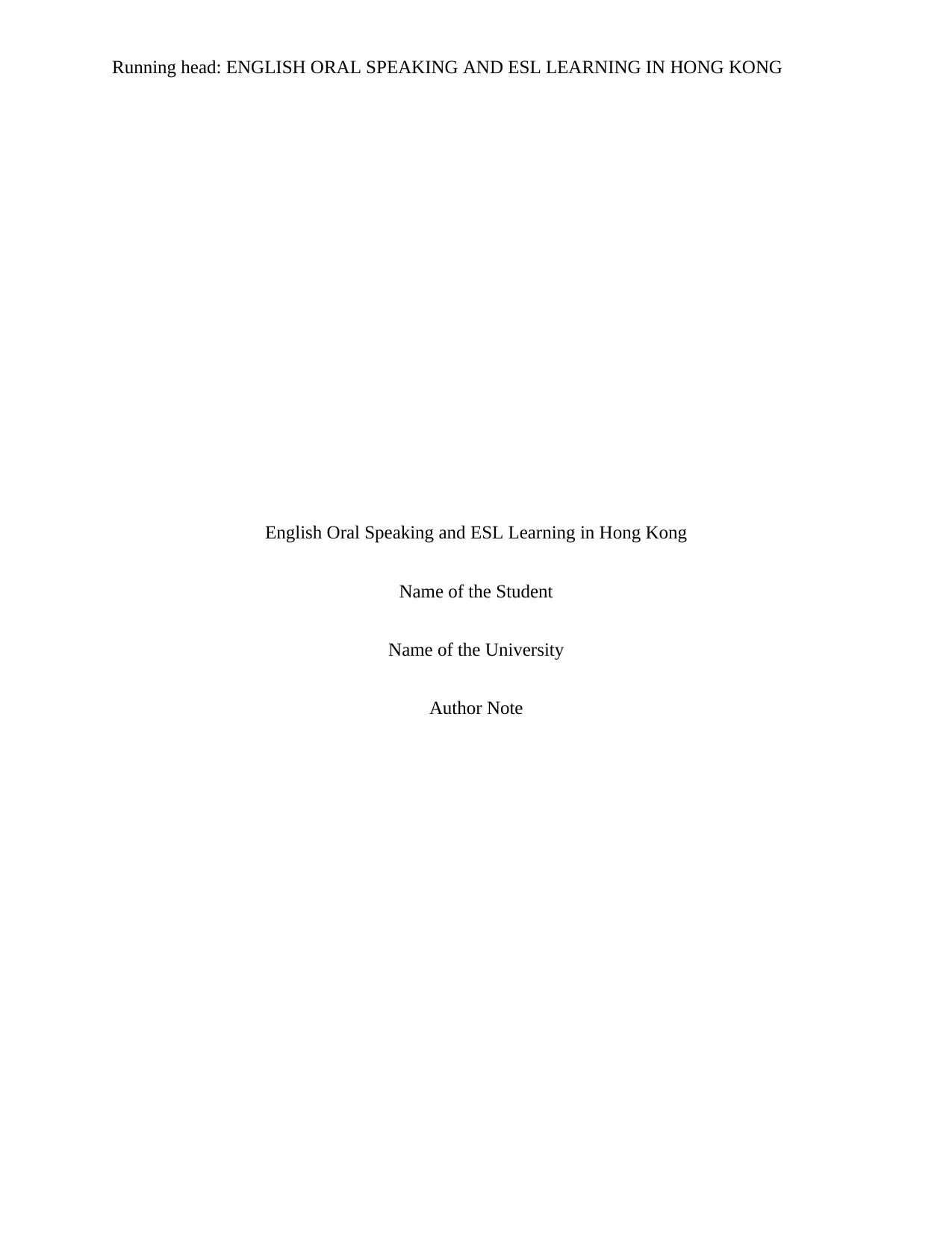
Running head: ENGLISH ORAL SPEAKING AND ESL LEARNING IN HONG KONG
English Oral Speaking and ESL Learning in Hong Kong
Name of the Student
Name of the University
Author Note
English Oral Speaking and ESL Learning in Hong Kong
Name of the Student
Name of the University
Author Note
Paraphrase This Document
Need a fresh take? Get an instant paraphrase of this document with our AI Paraphraser
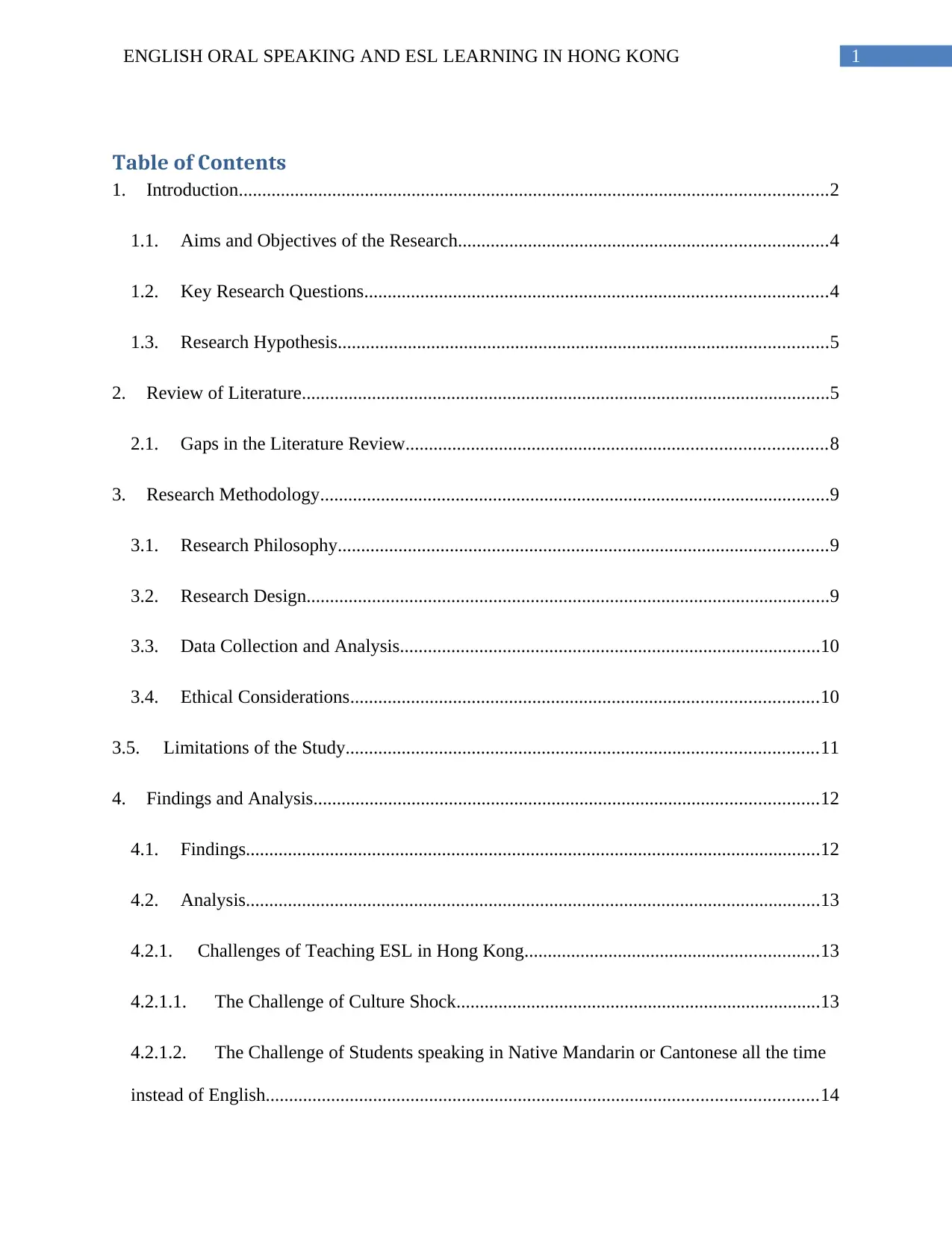
1ENGLISH ORAL SPEAKING AND ESL LEARNING IN HONG KONG
Table of Contents
1. Introduction..............................................................................................................................2
1.1. Aims and Objectives of the Research...............................................................................4
1.2. Key Research Questions...................................................................................................4
1.3. Research Hypothesis.........................................................................................................5
2. Review of Literature.................................................................................................................5
2.1. Gaps in the Literature Review..........................................................................................8
3. Research Methodology.............................................................................................................9
3.1. Research Philosophy.........................................................................................................9
3.2. Research Design................................................................................................................9
3.3. Data Collection and Analysis..........................................................................................10
3.4. Ethical Considerations....................................................................................................10
3.5. Limitations of the Study.....................................................................................................11
4. Findings and Analysis............................................................................................................12
4.1. Findings...........................................................................................................................12
4.2. Analysis...........................................................................................................................13
4.2.1. Challenges of Teaching ESL in Hong Kong...............................................................13
4.2.1.1. The Challenge of Culture Shock..............................................................................13
4.2.1.2. The Challenge of Students speaking in Native Mandarin or Cantonese all the time
instead of English......................................................................................................................14
Table of Contents
1. Introduction..............................................................................................................................2
1.1. Aims and Objectives of the Research...............................................................................4
1.2. Key Research Questions...................................................................................................4
1.3. Research Hypothesis.........................................................................................................5
2. Review of Literature.................................................................................................................5
2.1. Gaps in the Literature Review..........................................................................................8
3. Research Methodology.............................................................................................................9
3.1. Research Philosophy.........................................................................................................9
3.2. Research Design................................................................................................................9
3.3. Data Collection and Analysis..........................................................................................10
3.4. Ethical Considerations....................................................................................................10
3.5. Limitations of the Study.....................................................................................................11
4. Findings and Analysis............................................................................................................12
4.1. Findings...........................................................................................................................12
4.2. Analysis...........................................................................................................................13
4.2.1. Challenges of Teaching ESL in Hong Kong...............................................................13
4.2.1.1. The Challenge of Culture Shock..............................................................................13
4.2.1.2. The Challenge of Students speaking in Native Mandarin or Cantonese all the time
instead of English......................................................................................................................14
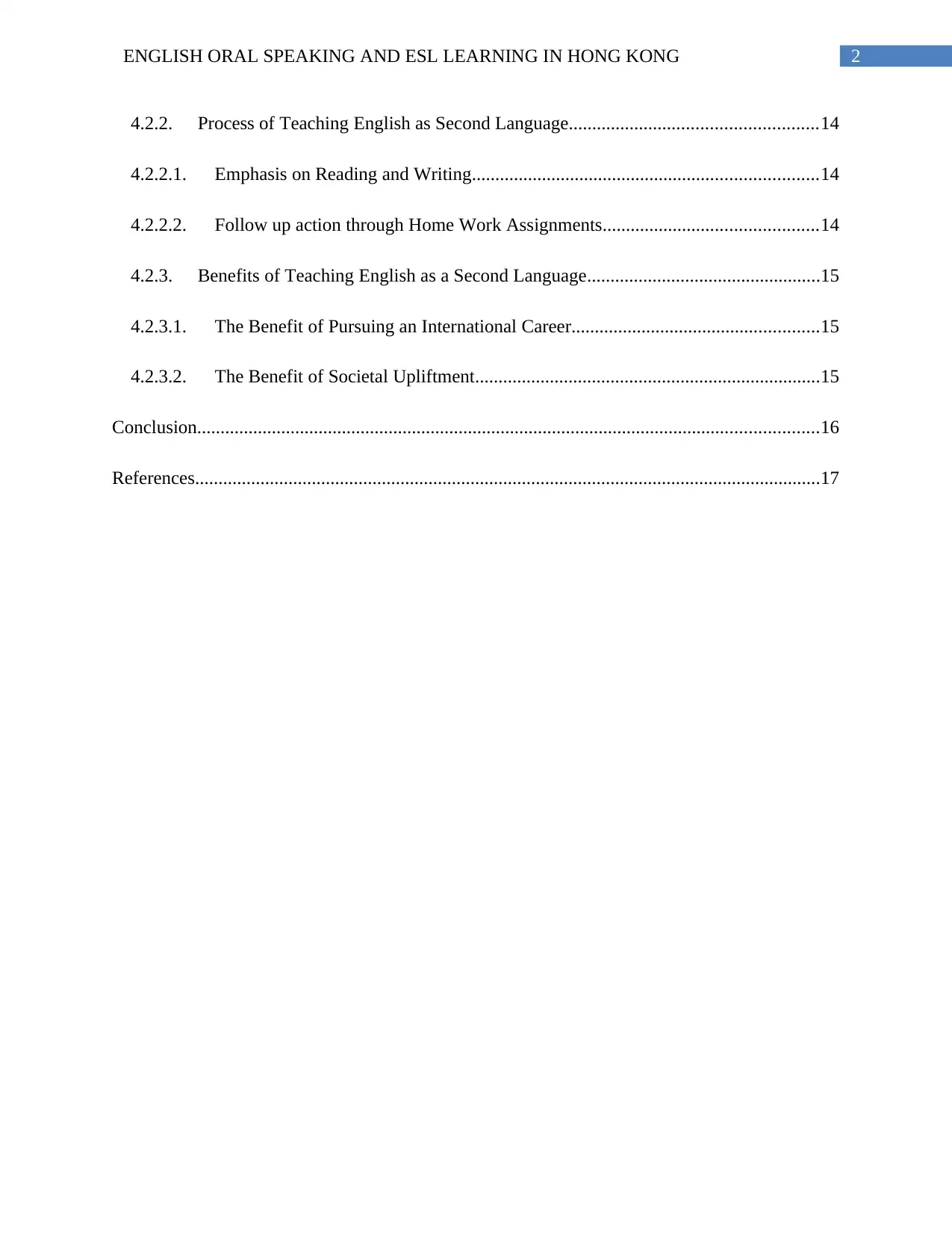
2ENGLISH ORAL SPEAKING AND ESL LEARNING IN HONG KONG
4.2.2. Process of Teaching English as Second Language.....................................................14
4.2.2.1. Emphasis on Reading and Writing..........................................................................14
4.2.2.2. Follow up action through Home Work Assignments..............................................14
4.2.3. Benefits of Teaching English as a Second Language..................................................15
4.2.3.1. The Benefit of Pursuing an International Career.....................................................15
4.2.3.2. The Benefit of Societal Upliftment..........................................................................15
Conclusion.....................................................................................................................................16
References......................................................................................................................................17
4.2.2. Process of Teaching English as Second Language.....................................................14
4.2.2.1. Emphasis on Reading and Writing..........................................................................14
4.2.2.2. Follow up action through Home Work Assignments..............................................14
4.2.3. Benefits of Teaching English as a Second Language..................................................15
4.2.3.1. The Benefit of Pursuing an International Career.....................................................15
4.2.3.2. The Benefit of Societal Upliftment..........................................................................15
Conclusion.....................................................................................................................................16
References......................................................................................................................................17
⊘ This is a preview!⊘
Do you want full access?
Subscribe today to unlock all pages.

Trusted by 1+ million students worldwide
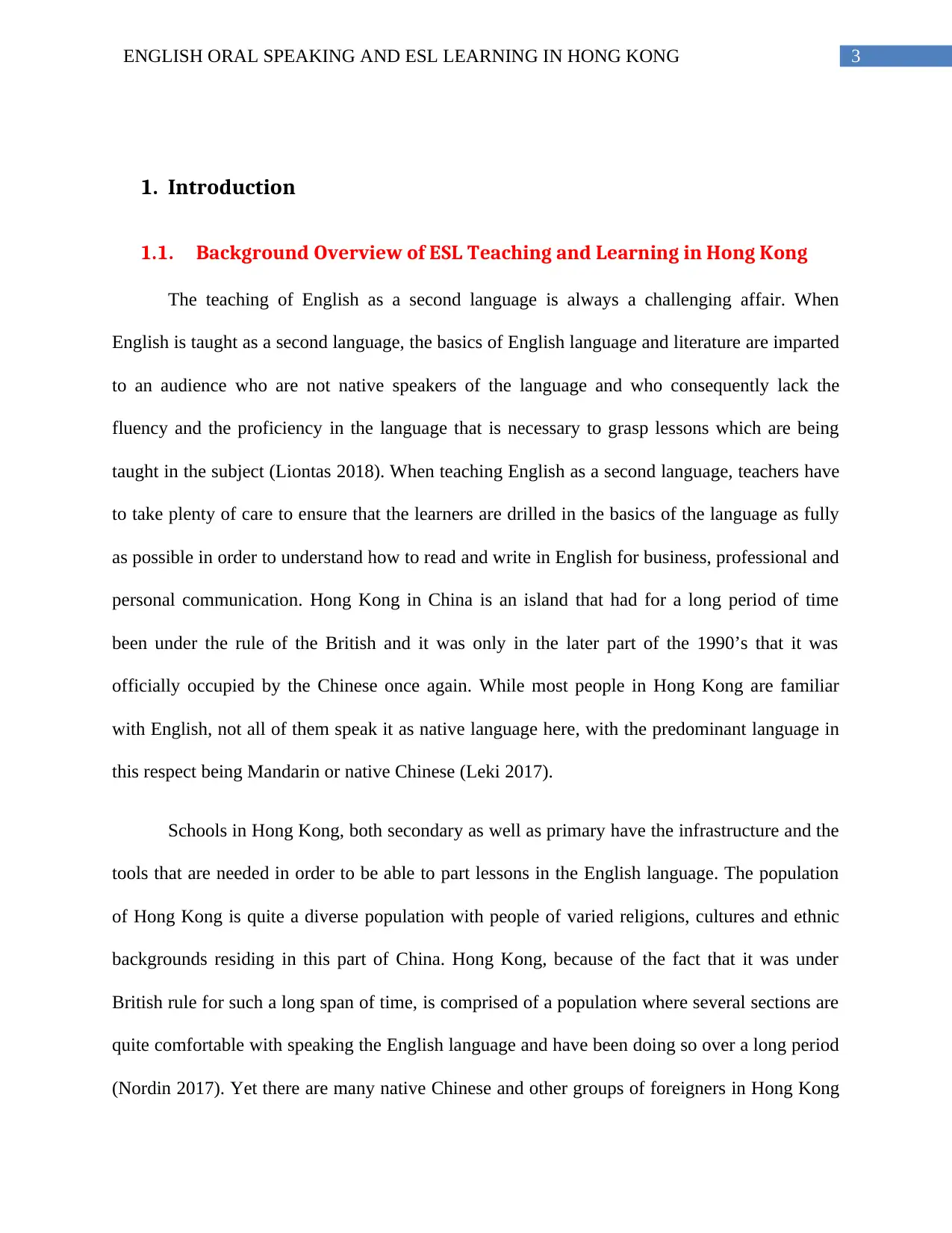
3ENGLISH ORAL SPEAKING AND ESL LEARNING IN HONG KONG
1. Introduction
1.1. Background Overview of ESL Teaching and Learning in Hong Kong
The teaching of English as a second language is always a challenging affair. When
English is taught as a second language, the basics of English language and literature are imparted
to an audience who are not native speakers of the language and who consequently lack the
fluency and the proficiency in the language that is necessary to grasp lessons which are being
taught in the subject (Liontas 2018). When teaching English as a second language, teachers have
to take plenty of care to ensure that the learners are drilled in the basics of the language as fully
as possible in order to understand how to read and write in English for business, professional and
personal communication. Hong Kong in China is an island that had for a long period of time
been under the rule of the British and it was only in the later part of the 1990’s that it was
officially occupied by the Chinese once again. While most people in Hong Kong are familiar
with English, not all of them speak it as native language here, with the predominant language in
this respect being Mandarin or native Chinese (Leki 2017).
Schools in Hong Kong, both secondary as well as primary have the infrastructure and the
tools that are needed in order to be able to part lessons in the English language. The population
of Hong Kong is quite a diverse population with people of varied religions, cultures and ethnic
backgrounds residing in this part of China. Hong Kong, because of the fact that it was under
British rule for such a long span of time, is comprised of a population where several sections are
quite comfortable with speaking the English language and have been doing so over a long period
(Nordin 2017). Yet there are many native Chinese and other groups of foreigners in Hong Kong
1. Introduction
1.1. Background Overview of ESL Teaching and Learning in Hong Kong
The teaching of English as a second language is always a challenging affair. When
English is taught as a second language, the basics of English language and literature are imparted
to an audience who are not native speakers of the language and who consequently lack the
fluency and the proficiency in the language that is necessary to grasp lessons which are being
taught in the subject (Liontas 2018). When teaching English as a second language, teachers have
to take plenty of care to ensure that the learners are drilled in the basics of the language as fully
as possible in order to understand how to read and write in English for business, professional and
personal communication. Hong Kong in China is an island that had for a long period of time
been under the rule of the British and it was only in the later part of the 1990’s that it was
officially occupied by the Chinese once again. While most people in Hong Kong are familiar
with English, not all of them speak it as native language here, with the predominant language in
this respect being Mandarin or native Chinese (Leki 2017).
Schools in Hong Kong, both secondary as well as primary have the infrastructure and the
tools that are needed in order to be able to part lessons in the English language. The population
of Hong Kong is quite a diverse population with people of varied religions, cultures and ethnic
backgrounds residing in this part of China. Hong Kong, because of the fact that it was under
British rule for such a long span of time, is comprised of a population where several sections are
quite comfortable with speaking the English language and have been doing so over a long period
(Nordin 2017). Yet there are many native Chinese and other groups of foreigners in Hong Kong
Paraphrase This Document
Need a fresh take? Get an instant paraphrase of this document with our AI Paraphraser
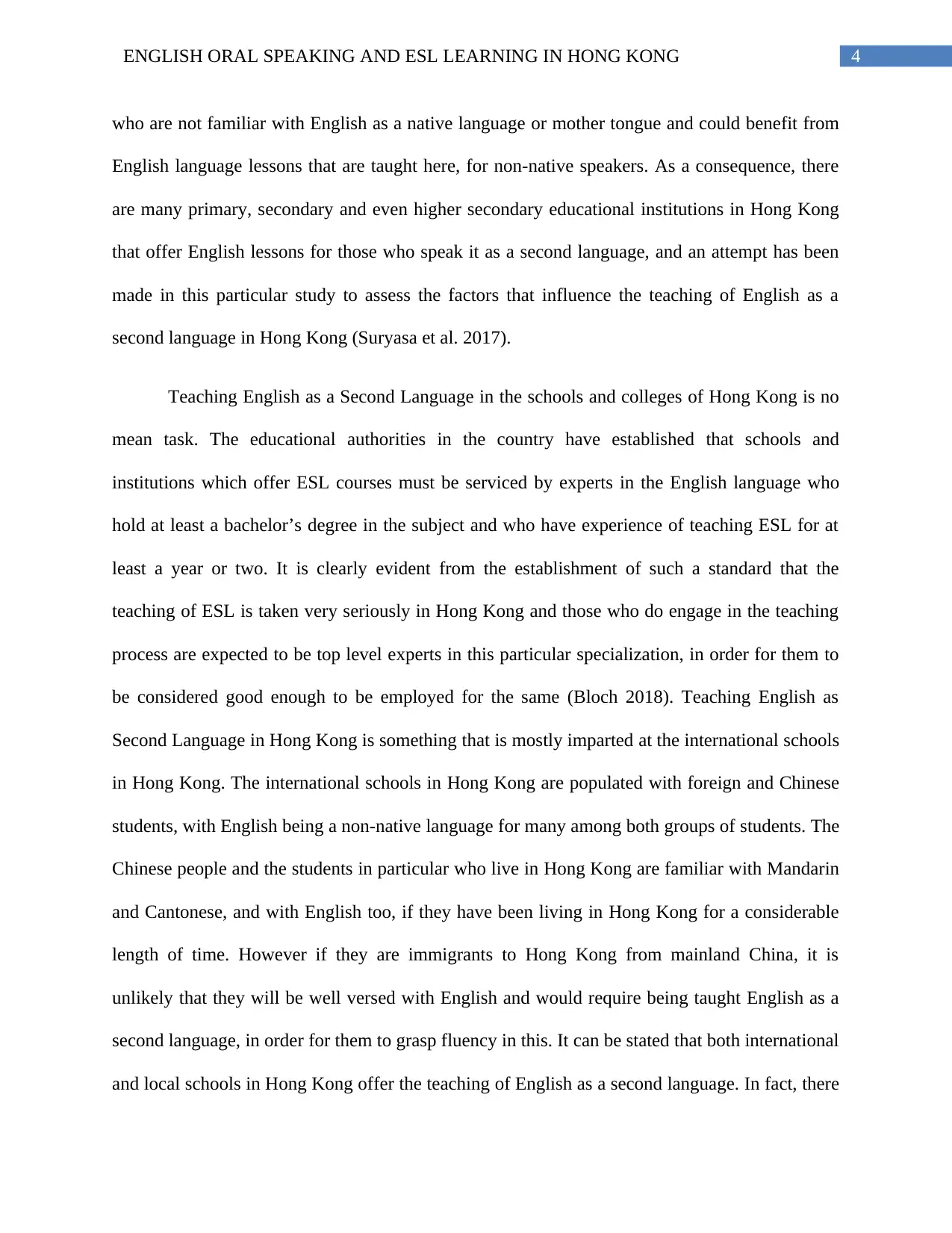
4ENGLISH ORAL SPEAKING AND ESL LEARNING IN HONG KONG
who are not familiar with English as a native language or mother tongue and could benefit from
English language lessons that are taught here, for non-native speakers. As a consequence, there
are many primary, secondary and even higher secondary educational institutions in Hong Kong
that offer English lessons for those who speak it as a second language, and an attempt has been
made in this particular study to assess the factors that influence the teaching of English as a
second language in Hong Kong (Suryasa et al. 2017).
Teaching English as a Second Language in the schools and colleges of Hong Kong is no
mean task. The educational authorities in the country have established that schools and
institutions which offer ESL courses must be serviced by experts in the English language who
hold at least a bachelor’s degree in the subject and who have experience of teaching ESL for at
least a year or two. It is clearly evident from the establishment of such a standard that the
teaching of ESL is taken very seriously in Hong Kong and those who do engage in the teaching
process are expected to be top level experts in this particular specialization, in order for them to
be considered good enough to be employed for the same (Bloch 2018). Teaching English as
Second Language in Hong Kong is something that is mostly imparted at the international schools
in Hong Kong. The international schools in Hong Kong are populated with foreign and Chinese
students, with English being a non-native language for many among both groups of students. The
Chinese people and the students in particular who live in Hong Kong are familiar with Mandarin
and Cantonese, and with English too, if they have been living in Hong Kong for a considerable
length of time. However if they are immigrants to Hong Kong from mainland China, it is
unlikely that they will be well versed with English and would require being taught English as a
second language, in order for them to grasp fluency in this. It can be stated that both international
and local schools in Hong Kong offer the teaching of English as a second language. In fact, there
who are not familiar with English as a native language or mother tongue and could benefit from
English language lessons that are taught here, for non-native speakers. As a consequence, there
are many primary, secondary and even higher secondary educational institutions in Hong Kong
that offer English lessons for those who speak it as a second language, and an attempt has been
made in this particular study to assess the factors that influence the teaching of English as a
second language in Hong Kong (Suryasa et al. 2017).
Teaching English as a Second Language in the schools and colleges of Hong Kong is no
mean task. The educational authorities in the country have established that schools and
institutions which offer ESL courses must be serviced by experts in the English language who
hold at least a bachelor’s degree in the subject and who have experience of teaching ESL for at
least a year or two. It is clearly evident from the establishment of such a standard that the
teaching of ESL is taken very seriously in Hong Kong and those who do engage in the teaching
process are expected to be top level experts in this particular specialization, in order for them to
be considered good enough to be employed for the same (Bloch 2018). Teaching English as
Second Language in Hong Kong is something that is mostly imparted at the international schools
in Hong Kong. The international schools in Hong Kong are populated with foreign and Chinese
students, with English being a non-native language for many among both groups of students. The
Chinese people and the students in particular who live in Hong Kong are familiar with Mandarin
and Cantonese, and with English too, if they have been living in Hong Kong for a considerable
length of time. However if they are immigrants to Hong Kong from mainland China, it is
unlikely that they will be well versed with English and would require being taught English as a
second language, in order for them to grasp fluency in this. It can be stated that both international
and local schools in Hong Kong offer the teaching of English as a second language. In fact, there
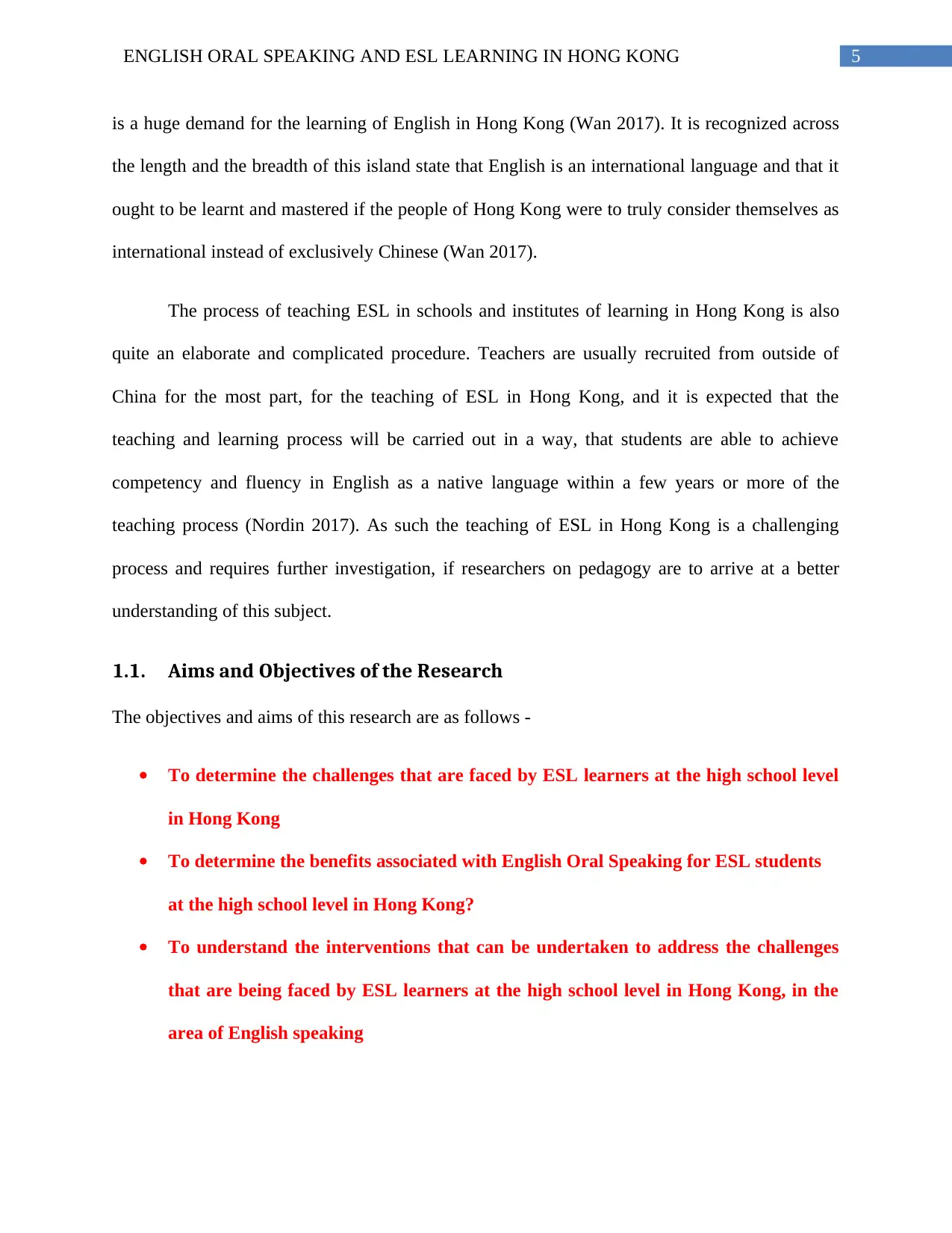
5ENGLISH ORAL SPEAKING AND ESL LEARNING IN HONG KONG
is a huge demand for the learning of English in Hong Kong (Wan 2017). It is recognized across
the length and the breadth of this island state that English is an international language and that it
ought to be learnt and mastered if the people of Hong Kong were to truly consider themselves as
international instead of exclusively Chinese (Wan 2017).
The process of teaching ESL in schools and institutes of learning in Hong Kong is also
quite an elaborate and complicated procedure. Teachers are usually recruited from outside of
China for the most part, for the teaching of ESL in Hong Kong, and it is expected that the
teaching and learning process will be carried out in a way, that students are able to achieve
competency and fluency in English as a native language within a few years or more of the
teaching process (Nordin 2017). As such the teaching of ESL in Hong Kong is a challenging
process and requires further investigation, if researchers on pedagogy are to arrive at a better
understanding of this subject.
1.1. Aims and Objectives of the Research
The objectives and aims of this research are as follows -
To determine the challenges that are faced by ESL learners at the high school level
in Hong Kong
To determine the benefits associated with English Oral Speaking for ESL students
at the high school level in Hong Kong?
To understand the interventions that can be undertaken to address the challenges
that are being faced by ESL learners at the high school level in Hong Kong, in the
area of English speaking
is a huge demand for the learning of English in Hong Kong (Wan 2017). It is recognized across
the length and the breadth of this island state that English is an international language and that it
ought to be learnt and mastered if the people of Hong Kong were to truly consider themselves as
international instead of exclusively Chinese (Wan 2017).
The process of teaching ESL in schools and institutes of learning in Hong Kong is also
quite an elaborate and complicated procedure. Teachers are usually recruited from outside of
China for the most part, for the teaching of ESL in Hong Kong, and it is expected that the
teaching and learning process will be carried out in a way, that students are able to achieve
competency and fluency in English as a native language within a few years or more of the
teaching process (Nordin 2017). As such the teaching of ESL in Hong Kong is a challenging
process and requires further investigation, if researchers on pedagogy are to arrive at a better
understanding of this subject.
1.1. Aims and Objectives of the Research
The objectives and aims of this research are as follows -
To determine the challenges that are faced by ESL learners at the high school level
in Hong Kong
To determine the benefits associated with English Oral Speaking for ESL students
at the high school level in Hong Kong?
To understand the interventions that can be undertaken to address the challenges
that are being faced by ESL learners at the high school level in Hong Kong, in the
area of English speaking
⊘ This is a preview!⊘
Do you want full access?
Subscribe today to unlock all pages.

Trusted by 1+ million students worldwide
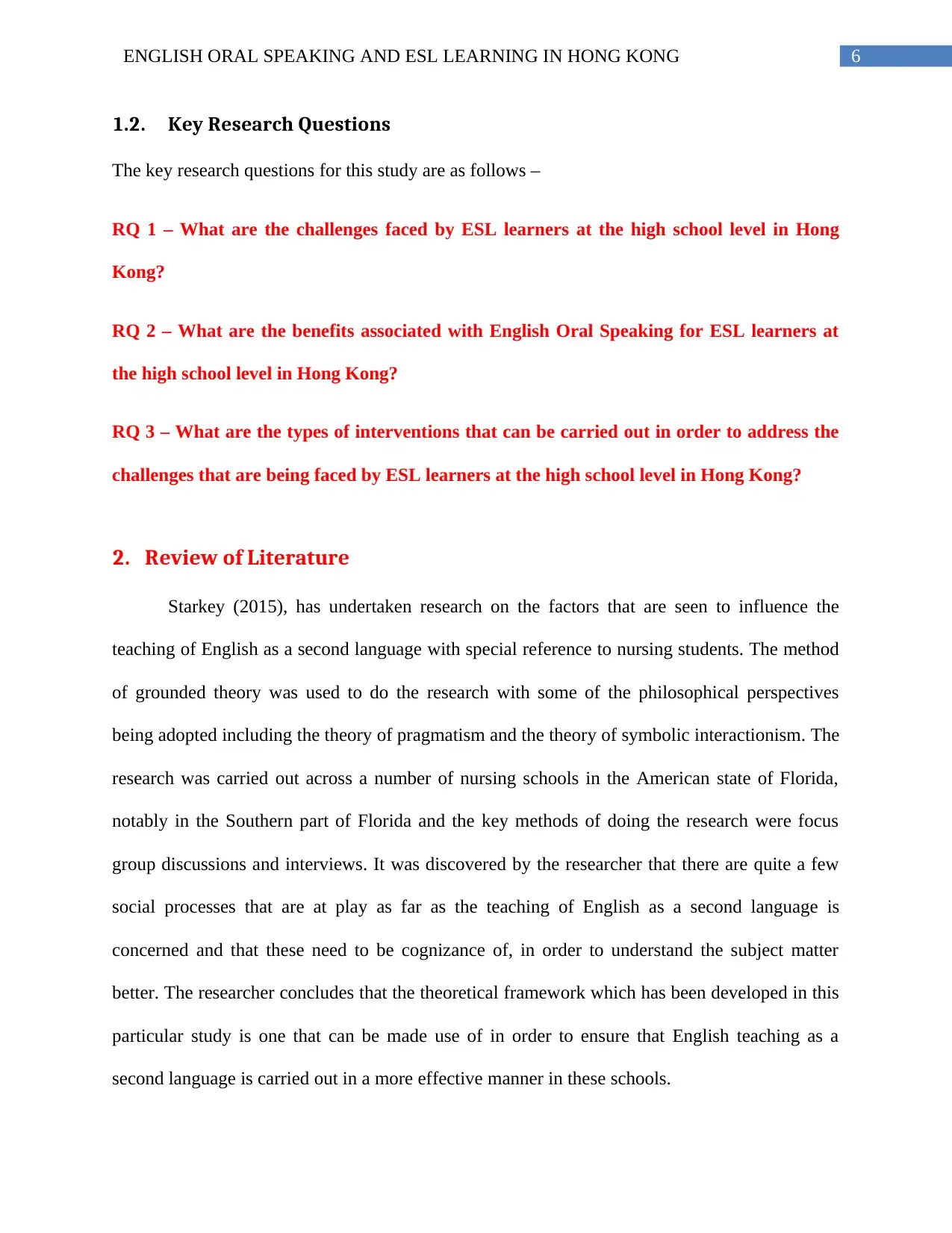
6ENGLISH ORAL SPEAKING AND ESL LEARNING IN HONG KONG
1.2. Key Research Questions
The key research questions for this study are as follows –
RQ 1 – What are the challenges faced by ESL learners at the high school level in Hong
Kong?
RQ 2 – What are the benefits associated with English Oral Speaking for ESL learners at
the high school level in Hong Kong?
RQ 3 – What are the types of interventions that can be carried out in order to address the
challenges that are being faced by ESL learners at the high school level in Hong Kong?
2. Review of Literature
Starkey (2015), has undertaken research on the factors that are seen to influence the
teaching of English as a second language with special reference to nursing students. The method
of grounded theory was used to do the research with some of the philosophical perspectives
being adopted including the theory of pragmatism and the theory of symbolic interactionism. The
research was carried out across a number of nursing schools in the American state of Florida,
notably in the Southern part of Florida and the key methods of doing the research were focus
group discussions and interviews. It was discovered by the researcher that there are quite a few
social processes that are at play as far as the teaching of English as a second language is
concerned and that these need to be cognizance of, in order to understand the subject matter
better. The researcher concludes that the theoretical framework which has been developed in this
particular study is one that can be made use of in order to ensure that English teaching as a
second language is carried out in a more effective manner in these schools.
1.2. Key Research Questions
The key research questions for this study are as follows –
RQ 1 – What are the challenges faced by ESL learners at the high school level in Hong
Kong?
RQ 2 – What are the benefits associated with English Oral Speaking for ESL learners at
the high school level in Hong Kong?
RQ 3 – What are the types of interventions that can be carried out in order to address the
challenges that are being faced by ESL learners at the high school level in Hong Kong?
2. Review of Literature
Starkey (2015), has undertaken research on the factors that are seen to influence the
teaching of English as a second language with special reference to nursing students. The method
of grounded theory was used to do the research with some of the philosophical perspectives
being adopted including the theory of pragmatism and the theory of symbolic interactionism. The
research was carried out across a number of nursing schools in the American state of Florida,
notably in the Southern part of Florida and the key methods of doing the research were focus
group discussions and interviews. It was discovered by the researcher that there are quite a few
social processes that are at play as far as the teaching of English as a second language is
concerned and that these need to be cognizance of, in order to understand the subject matter
better. The researcher concludes that the theoretical framework which has been developed in this
particular study is one that can be made use of in order to ensure that English teaching as a
second language is carried out in a more effective manner in these schools.
Paraphrase This Document
Need a fresh take? Get an instant paraphrase of this document with our AI Paraphraser

7ENGLISH ORAL SPEAKING AND ESL LEARNING IN HONG KONG
Bloch (2018) has researched on the type of technology that is made use of when teaching
English as a second language. The creation of the world wide web and the internet for instance, it
is argued by Bloch (2018) has truly transformed the way by which teaching takes place today,
and argues that this mode of teaching proves to be quite effective when imparting lessons in
English as a second language. In the view of Bloch (2018) creating and sharing text using the
medium of the internet in general and the World Wide Web in particular is something that can be
done quite quickly and easily. Furthermore, it is argued by Bloch (2018) that the existence of
social media platforms like Facebook, Twitter and Instagram and the presence of online
encyclopedias like Wikipedia all contribute to the effective way by which English is taught as a
second language in today’s day and age. It is the concluding argument of Bloch (2018) that
teachers need to take advantage of the huge demand that is associated with digital learning. They
need to understand the ease and efficiency of using digital learning platforms in order to impart
more effectively, lessons in English as second language.
The communicative approach in the teaching of English as a second language is
something that has been researched on by Wan (2017). The role that drama has to play when
teaching ESL is also something that has been well discussed in this piece of work. It is argued by
the researcher that teachers of English as second language need to take recourse to drama and to
literary drama in particular to understand the impact and the force that a language like English
can have on the reader or on the audience, in an effective manner. By incorporating the teaching
of drama in ESL lessons, it is the belief of the researchers that the basics of English as a second
language can be conveyed more easily and quickly to the students and they will be able to grasp
the lessons far better in the process. In other words what Wan (2017), calls for this piece of work
is the adoption of a communicative approach through the teaching of drama. This in the view of
Bloch (2018) has researched on the type of technology that is made use of when teaching
English as a second language. The creation of the world wide web and the internet for instance, it
is argued by Bloch (2018) has truly transformed the way by which teaching takes place today,
and argues that this mode of teaching proves to be quite effective when imparting lessons in
English as a second language. In the view of Bloch (2018) creating and sharing text using the
medium of the internet in general and the World Wide Web in particular is something that can be
done quite quickly and easily. Furthermore, it is argued by Bloch (2018) that the existence of
social media platforms like Facebook, Twitter and Instagram and the presence of online
encyclopedias like Wikipedia all contribute to the effective way by which English is taught as a
second language in today’s day and age. It is the concluding argument of Bloch (2018) that
teachers need to take advantage of the huge demand that is associated with digital learning. They
need to understand the ease and efficiency of using digital learning platforms in order to impart
more effectively, lessons in English as second language.
The communicative approach in the teaching of English as a second language is
something that has been researched on by Wan (2017). The role that drama has to play when
teaching ESL is also something that has been well discussed in this piece of work. It is argued by
the researcher that teachers of English as second language need to take recourse to drama and to
literary drama in particular to understand the impact and the force that a language like English
can have on the reader or on the audience, in an effective manner. By incorporating the teaching
of drama in ESL lessons, it is the belief of the researchers that the basics of English as a second
language can be conveyed more easily and quickly to the students and they will be able to grasp
the lessons far better in the process. In other words what Wan (2017), calls for this piece of work
is the adoption of a communicative approach through the teaching of drama. This in the view of
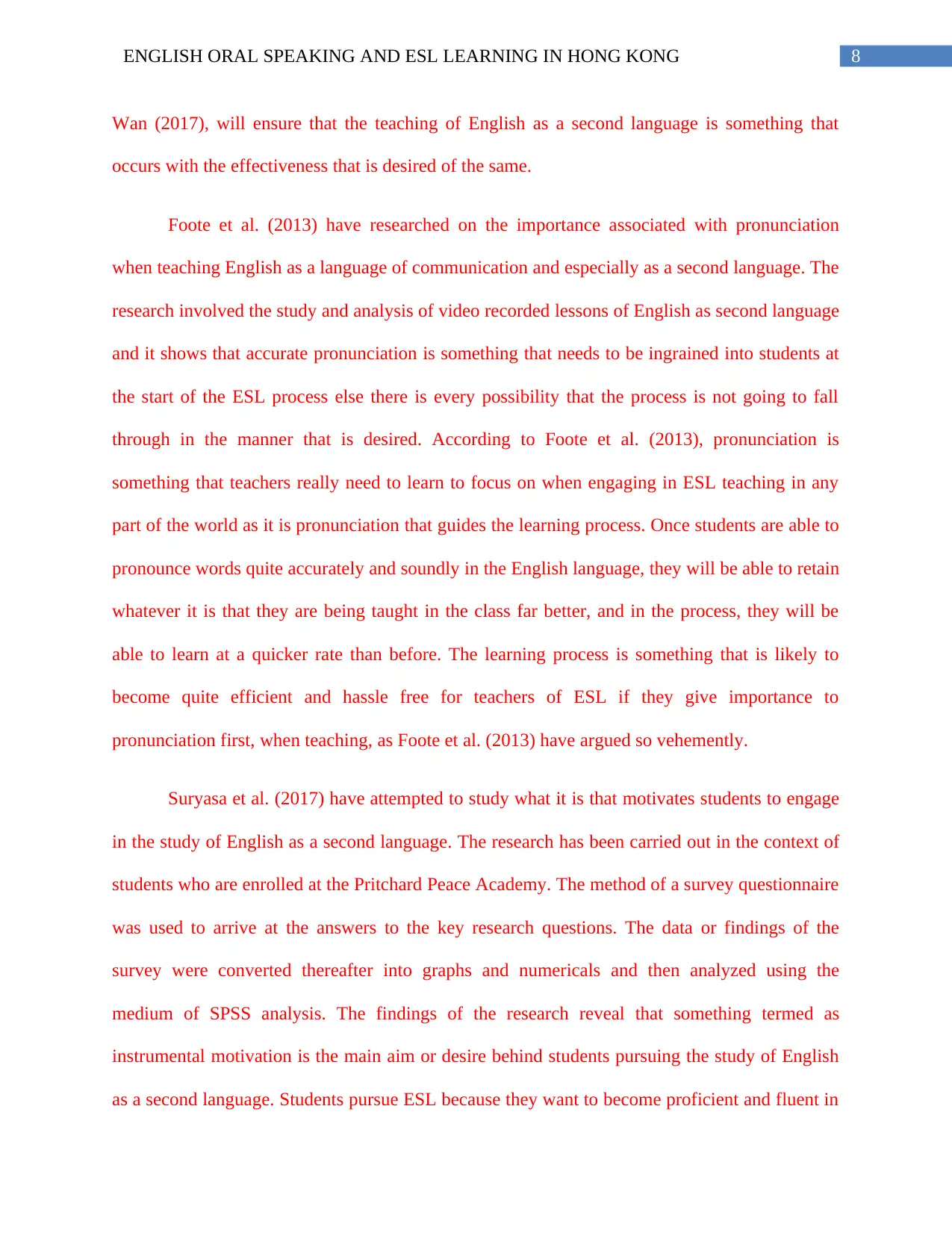
8ENGLISH ORAL SPEAKING AND ESL LEARNING IN HONG KONG
Wan (2017), will ensure that the teaching of English as a second language is something that
occurs with the effectiveness that is desired of the same.
Foote et al. (2013) have researched on the importance associated with pronunciation
when teaching English as a language of communication and especially as a second language. The
research involved the study and analysis of video recorded lessons of English as second language
and it shows that accurate pronunciation is something that needs to be ingrained into students at
the start of the ESL process else there is every possibility that the process is not going to fall
through in the manner that is desired. According to Foote et al. (2013), pronunciation is
something that teachers really need to learn to focus on when engaging in ESL teaching in any
part of the world as it is pronunciation that guides the learning process. Once students are able to
pronounce words quite accurately and soundly in the English language, they will be able to retain
whatever it is that they are being taught in the class far better, and in the process, they will be
able to learn at a quicker rate than before. The learning process is something that is likely to
become quite efficient and hassle free for teachers of ESL if they give importance to
pronunciation first, when teaching, as Foote et al. (2013) have argued so vehemently.
Suryasa et al. (2017) have attempted to study what it is that motivates students to engage
in the study of English as a second language. The research has been carried out in the context of
students who are enrolled at the Pritchard Peace Academy. The method of a survey questionnaire
was used to arrive at the answers to the key research questions. The data or findings of the
survey were converted thereafter into graphs and numericals and then analyzed using the
medium of SPSS analysis. The findings of the research reveal that something termed as
instrumental motivation is the main aim or desire behind students pursuing the study of English
as a second language. Students pursue ESL because they want to become proficient and fluent in
Wan (2017), will ensure that the teaching of English as a second language is something that
occurs with the effectiveness that is desired of the same.
Foote et al. (2013) have researched on the importance associated with pronunciation
when teaching English as a language of communication and especially as a second language. The
research involved the study and analysis of video recorded lessons of English as second language
and it shows that accurate pronunciation is something that needs to be ingrained into students at
the start of the ESL process else there is every possibility that the process is not going to fall
through in the manner that is desired. According to Foote et al. (2013), pronunciation is
something that teachers really need to learn to focus on when engaging in ESL teaching in any
part of the world as it is pronunciation that guides the learning process. Once students are able to
pronounce words quite accurately and soundly in the English language, they will be able to retain
whatever it is that they are being taught in the class far better, and in the process, they will be
able to learn at a quicker rate than before. The learning process is something that is likely to
become quite efficient and hassle free for teachers of ESL if they give importance to
pronunciation first, when teaching, as Foote et al. (2013) have argued so vehemently.
Suryasa et al. (2017) have attempted to study what it is that motivates students to engage
in the study of English as a second language. The research has been carried out in the context of
students who are enrolled at the Pritchard Peace Academy. The method of a survey questionnaire
was used to arrive at the answers to the key research questions. The data or findings of the
survey were converted thereafter into graphs and numericals and then analyzed using the
medium of SPSS analysis. The findings of the research reveal that something termed as
instrumental motivation is the main aim or desire behind students pursuing the study of English
as a second language. Students pursue ESL because they want to become proficient and fluent in
⊘ This is a preview!⊘
Do you want full access?
Subscribe today to unlock all pages.

Trusted by 1+ million students worldwide

9ENGLISH ORAL SPEAKING AND ESL LEARNING IN HONG KONG
the language and they want to be found speaking and writing in the language well enough. It is
concluded by Suryasa et al. (2017) that there are many other factors that also influence the study
of English as a second language but that these factors require further research and investigation
before a definitive conclusion can be arrived on the same.
Alharbi and Awadh (2015) have attempted to study how pronunciation is an important of
English language learning in Saudi schools, with special reference to the teaching and learning of
English as a second language. In the argument of the researchers, the absence of language
learning opportunities outside of the classroom set up and the limited use of English within the
classroom setup by the students is something that is seen to affect their speech or pronunciation
in the English language quite effectively. In the view of the researchers, problem solving as well
as critical thinking skills need to be deployed at the time of teaching English as a second
language in the Saudi schools. It is further recommended by Alharbi and Awadh (2015), that the
Saudi schools be transformed into what may be termed as bi-lingual schools in order for the
teaching to take place in a manner that can be considered as more effective.
2.1. Gaps in the Literature Review
The literature that has been reviewed above has pointed out the processes, by which ESL
teaching is engaged in for the most part, and the tips, techniques as well as methods that ought to
be taken into consideration when teaching English as a second language. The research has not
shed light on how English oral speaking can aid and assist ESL teaching and learning at
the high school level in Hong Kong and it is has not discussed the specific factors that
influence English Oral Speaking as part of ESL teaching and learning or the benefits
associated with the same. It is these gaps in the literature review and the present research
wishes to uncover.
the language and they want to be found speaking and writing in the language well enough. It is
concluded by Suryasa et al. (2017) that there are many other factors that also influence the study
of English as a second language but that these factors require further research and investigation
before a definitive conclusion can be arrived on the same.
Alharbi and Awadh (2015) have attempted to study how pronunciation is an important of
English language learning in Saudi schools, with special reference to the teaching and learning of
English as a second language. In the argument of the researchers, the absence of language
learning opportunities outside of the classroom set up and the limited use of English within the
classroom setup by the students is something that is seen to affect their speech or pronunciation
in the English language quite effectively. In the view of the researchers, problem solving as well
as critical thinking skills need to be deployed at the time of teaching English as a second
language in the Saudi schools. It is further recommended by Alharbi and Awadh (2015), that the
Saudi schools be transformed into what may be termed as bi-lingual schools in order for the
teaching to take place in a manner that can be considered as more effective.
2.1. Gaps in the Literature Review
The literature that has been reviewed above has pointed out the processes, by which ESL
teaching is engaged in for the most part, and the tips, techniques as well as methods that ought to
be taken into consideration when teaching English as a second language. The research has not
shed light on how English oral speaking can aid and assist ESL teaching and learning at
the high school level in Hong Kong and it is has not discussed the specific factors that
influence English Oral Speaking as part of ESL teaching and learning or the benefits
associated with the same. It is these gaps in the literature review and the present research
wishes to uncover.
Paraphrase This Document
Need a fresh take? Get an instant paraphrase of this document with our AI Paraphraser
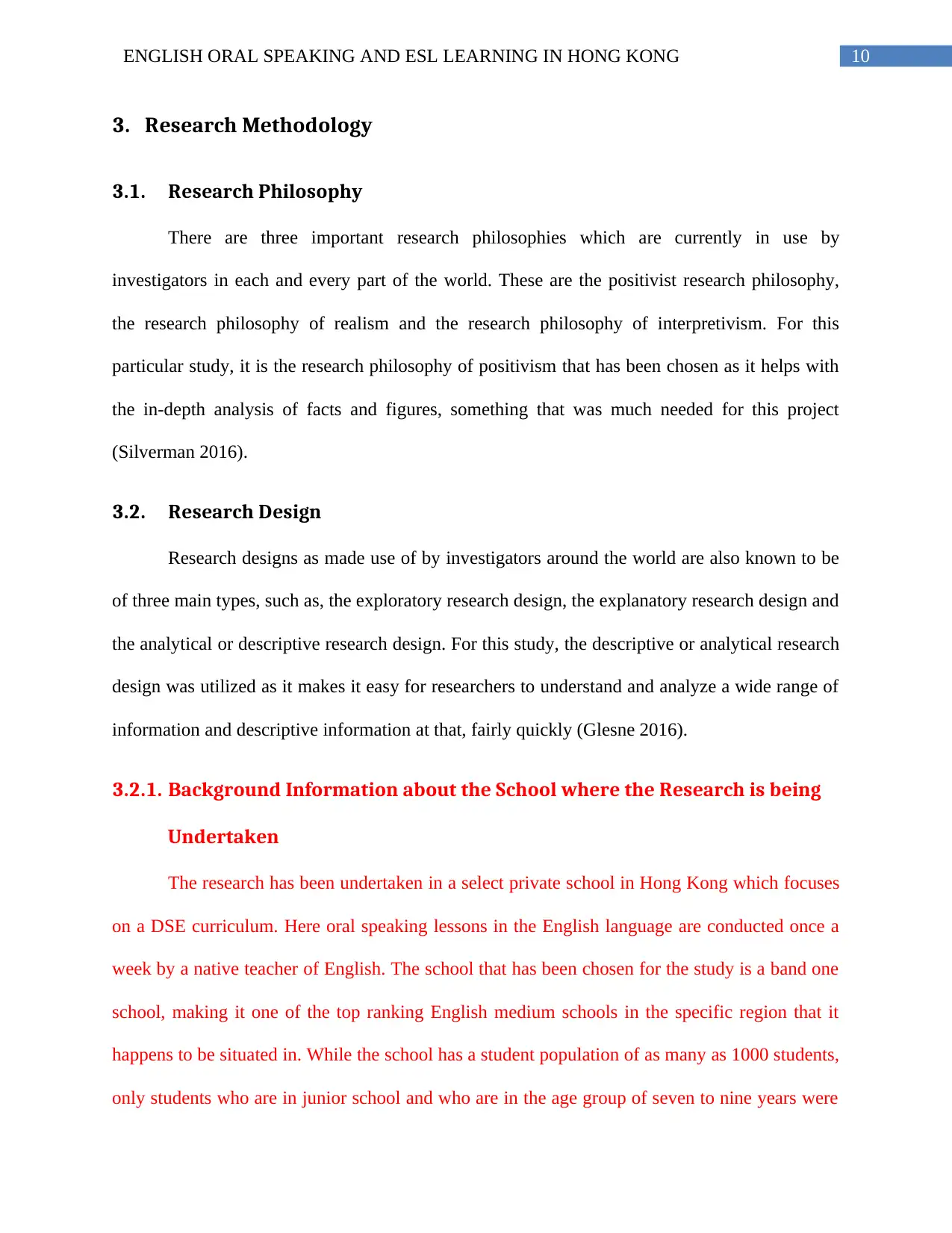
10ENGLISH ORAL SPEAKING AND ESL LEARNING IN HONG KONG
3. Research Methodology
3.1. Research Philosophy
There are three important research philosophies which are currently in use by
investigators in each and every part of the world. These are the positivist research philosophy,
the research philosophy of realism and the research philosophy of interpretivism. For this
particular study, it is the research philosophy of positivism that has been chosen as it helps with
the in-depth analysis of facts and figures, something that was much needed for this project
(Silverman 2016).
3.2. Research Design
Research designs as made use of by investigators around the world are also known to be
of three main types, such as, the exploratory research design, the explanatory research design and
the analytical or descriptive research design. For this study, the descriptive or analytical research
design was utilized as it makes it easy for researchers to understand and analyze a wide range of
information and descriptive information at that, fairly quickly (Glesne 2016).
3.2.1. Background Information about the School where the Research is being
Undertaken
The research has been undertaken in a select private school in Hong Kong which focuses
on a DSE curriculum. Here oral speaking lessons in the English language are conducted once a
week by a native teacher of English. The school that has been chosen for the study is a band one
school, making it one of the top ranking English medium schools in the specific region that it
happens to be situated in. While the school has a student population of as many as 1000 students,
only students who are in junior school and who are in the age group of seven to nine years were
3. Research Methodology
3.1. Research Philosophy
There are three important research philosophies which are currently in use by
investigators in each and every part of the world. These are the positivist research philosophy,
the research philosophy of realism and the research philosophy of interpretivism. For this
particular study, it is the research philosophy of positivism that has been chosen as it helps with
the in-depth analysis of facts and figures, something that was much needed for this project
(Silverman 2016).
3.2. Research Design
Research designs as made use of by investigators around the world are also known to be
of three main types, such as, the exploratory research design, the explanatory research design and
the analytical or descriptive research design. For this study, the descriptive or analytical research
design was utilized as it makes it easy for researchers to understand and analyze a wide range of
information and descriptive information at that, fairly quickly (Glesne 2016).
3.2.1. Background Information about the School where the Research is being
Undertaken
The research has been undertaken in a select private school in Hong Kong which focuses
on a DSE curriculum. Here oral speaking lessons in the English language are conducted once a
week by a native teacher of English. The school that has been chosen for the study is a band one
school, making it one of the top ranking English medium schools in the specific region that it
happens to be situated in. While the school has a student population of as many as 1000 students,
only students who are in junior school and who are in the age group of seven to nine years were
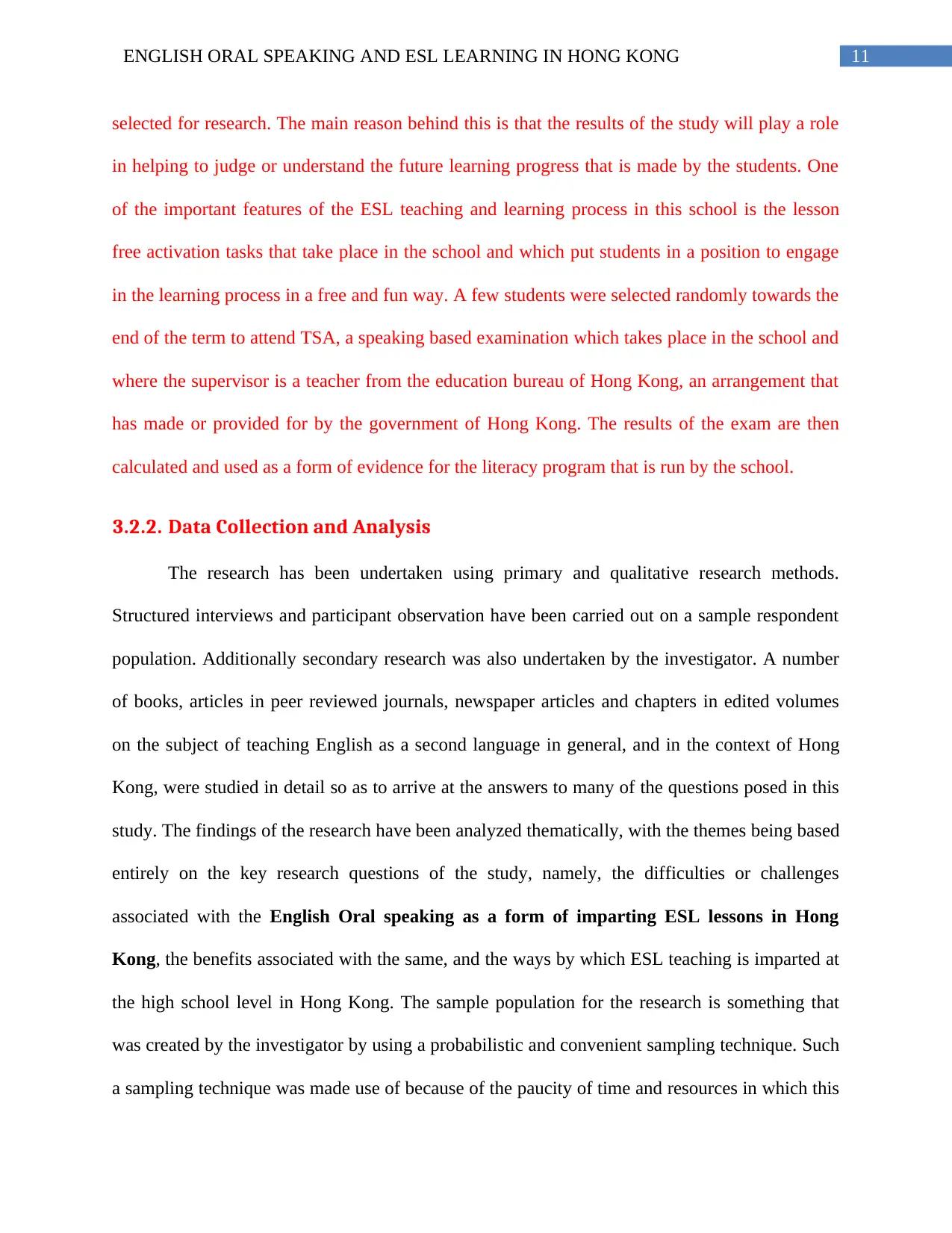
11ENGLISH ORAL SPEAKING AND ESL LEARNING IN HONG KONG
selected for research. The main reason behind this is that the results of the study will play a role
in helping to judge or understand the future learning progress that is made by the students. One
of the important features of the ESL teaching and learning process in this school is the lesson
free activation tasks that take place in the school and which put students in a position to engage
in the learning process in a free and fun way. A few students were selected randomly towards the
end of the term to attend TSA, a speaking based examination which takes place in the school and
where the supervisor is a teacher from the education bureau of Hong Kong, an arrangement that
has made or provided for by the government of Hong Kong. The results of the exam are then
calculated and used as a form of evidence for the literacy program that is run by the school.
3.2.2. Data Collection and Analysis
The research has been undertaken using primary and qualitative research methods.
Structured interviews and participant observation have been carried out on a sample respondent
population. Additionally secondary research was also undertaken by the investigator. A number
of books, articles in peer reviewed journals, newspaper articles and chapters in edited volumes
on the subject of teaching English as a second language in general, and in the context of Hong
Kong, were studied in detail so as to arrive at the answers to many of the questions posed in this
study. The findings of the research have been analyzed thematically, with the themes being based
entirely on the key research questions of the study, namely, the difficulties or challenges
associated with the English Oral speaking as a form of imparting ESL lessons in Hong
Kong, the benefits associated with the same, and the ways by which ESL teaching is imparted at
the high school level in Hong Kong. The sample population for the research is something that
was created by the investigator by using a probabilistic and convenient sampling technique. Such
a sampling technique was made use of because of the paucity of time and resources in which this
selected for research. The main reason behind this is that the results of the study will play a role
in helping to judge or understand the future learning progress that is made by the students. One
of the important features of the ESL teaching and learning process in this school is the lesson
free activation tasks that take place in the school and which put students in a position to engage
in the learning process in a free and fun way. A few students were selected randomly towards the
end of the term to attend TSA, a speaking based examination which takes place in the school and
where the supervisor is a teacher from the education bureau of Hong Kong, an arrangement that
has made or provided for by the government of Hong Kong. The results of the exam are then
calculated and used as a form of evidence for the literacy program that is run by the school.
3.2.2. Data Collection and Analysis
The research has been undertaken using primary and qualitative research methods.
Structured interviews and participant observation have been carried out on a sample respondent
population. Additionally secondary research was also undertaken by the investigator. A number
of books, articles in peer reviewed journals, newspaper articles and chapters in edited volumes
on the subject of teaching English as a second language in general, and in the context of Hong
Kong, were studied in detail so as to arrive at the answers to many of the questions posed in this
study. The findings of the research have been analyzed thematically, with the themes being based
entirely on the key research questions of the study, namely, the difficulties or challenges
associated with the English Oral speaking as a form of imparting ESL lessons in Hong
Kong, the benefits associated with the same, and the ways by which ESL teaching is imparted at
the high school level in Hong Kong. The sample population for the research is something that
was created by the investigator by using a probabilistic and convenient sampling technique. Such
a sampling technique was made use of because of the paucity of time and resources in which this
⊘ This is a preview!⊘
Do you want full access?
Subscribe today to unlock all pages.

Trusted by 1+ million students worldwide
1 out of 22
Related Documents
Your All-in-One AI-Powered Toolkit for Academic Success.
+13062052269
info@desklib.com
Available 24*7 on WhatsApp / Email
![[object Object]](/_next/static/media/star-bottom.7253800d.svg)
Unlock your academic potential
Copyright © 2020–2025 A2Z Services. All Rights Reserved. Developed and managed by ZUCOL.





